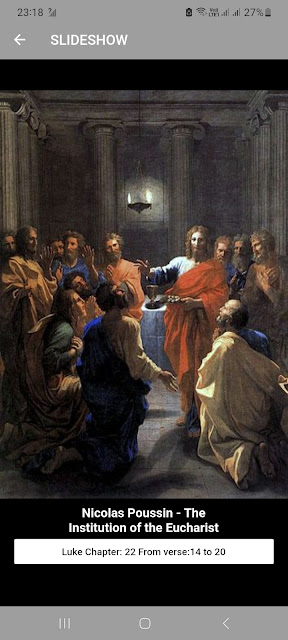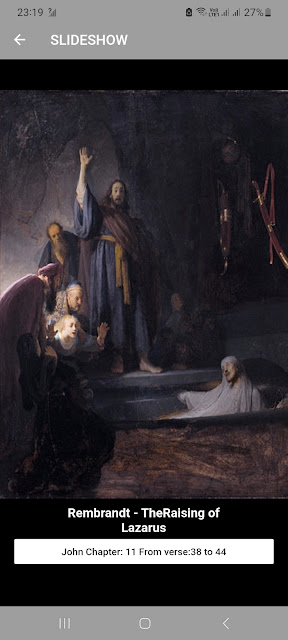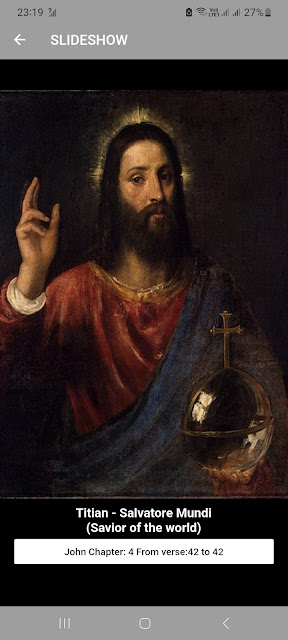We continue from the last post, Paintings of Christ crucified app 2.
1. James Tissot Sermon on the Beatitudes
The painting "Sermon on the Beatitudes" was created by French artist James Tissot in the late 19th century. It depicts Jesus Christ preaching to a large crowd on a mountainside, as described in the Biblical passage known as the "Sermon on the Mount" (Matthew 5-7).
In the painting, Jesus is shown seated on a rock, with his disciples and the audience gathered around him. He is gesturing with his hands and looking upwards, as if in deep thought or contemplation. The crowd includes men, women, and children, dressed in various traditional garments of the period.
Tissot's painting is notable for its realistic and detailed portrayal of the scene, as well as its use of light and shadow to create a sense of depth and perspective. The painting is part of a larger series of works by Tissot on the life and teachings of Jesus, which were exhibited in Paris and London in the 1890s and have since been widely acclaimed for their artistic and spiritual value.
2. John La Farge's "The Visit of Nicodemus to Christ"
John La Farge's painting "The Visit of Nicodemus to Christ" depicts the biblical account of Nicodemus, a Pharisee and member of the Sanhedrin, who visited Jesus at night to learn more about his teachings.
In the painting, Nicodemus is shown sitting before Jesus, who is seated in a peaceful and contemplative pose. The figures are bathed in soft, warm light, which emphasizes the intimacy and seriousness of their conversation. Nicodemus is portrayed with a humble and reverent expression, while Jesus is shown with a calm and wise demeanor.
La Farge's painting is known for its beautiful use of color and light, as well as its sensitive and empathetic portrayal of the relationship between Nicodemus and Jesus. The painting has been praised for its ability to convey the spiritual depth and meaning of the biblical story, and for its overall beauty and emotional power.
3. Esteban Murillo Stoning of Saint Stephen
"The Stoning of Saint Stephen" by the Spanish Baroque artist Esteban Murillo depicts the biblical account of the martyrdom of Saint Stephen, who was stoned to death for preaching about Jesus Christ.
In the painting, Stephen is shown kneeling in prayer, looking up to heaven, as he is surrounded by a violent mob of people who are throwing stones at him. The scene is depicted with intense emotion and drama, with the figures shown in dynamic poses and with vivid expressions of anger and fear.
4. Nicolas Poussin "The Institution of the Eucharist"
Nicolas Poussin's painting "The Institution of the Eucharist" depicts the biblical scene of the Last Supper, where Jesus gathered with his disciples to share a final meal before his crucifixion.
In the painting, Jesus is shown seated at the center of the table, surrounded by his disciples. He is holding a piece of bread, which he is blessing and offering to his followers as a symbol of his body. On the table, there are also chalices of wine, which Jesus is also offering to his disciples as a symbol of his blood.
Poussin's painting is known for its restrained and solemn mood, with the figures depicted in classical poses and with a sense of calm and serenity. The painting is also notable for its use of light and shadow, which creates a sense of depth and atmosphere.
5. Novgorod Virgin and Child
The Novgorod School of icon painting in Russia was active from the 12th to the 15th centuries, and produced many beautiful icons, including those depicting the Virgin and Child.
The Novgorod Virgin and Child icons are known for their expressive and tender portrayal of the relationship between Mary and Jesus, with the figures often shown gazing lovingly at each other. The iconography of the Virgin and Child also carries important theological meaning, as Mary is seen as the mother of God and Jesus is seen as the savior of humanity.
6. Nicolas Poussin's "The Baptism of Christ"
Nicolas Poussin's painting "The Baptism of Christ" depicts the biblical scene of the baptism of Jesus by John the Baptist in the River Jordan.
Poussin's "The Baptism of Christ" is known for its use of light and shadow, which creates a sense of depth and atmosphere. The painting is also notable for its attention to detail, with each element of the scene carefully rendered and given its own significance.
7. Rembrandt's "The Raising of Lazarus"
View more Images here
Rembrandt's painting "The Raising of Lazarus" is a dramatic depiction of the biblical story in which Jesus raises Lazarus from the dead.
In the painting, Lazarus is shown emerging from his tomb, his body wrapped in graveclothes. Jesus stands before him, his hand raised in a gesture of divine power. The figures in the painting are illuminated by a shaft of light that falls across the scene from an unseen source, creating a sense of drama and intensity.
Rembrandt's use of light and shadow is particularly striking, with the figures emerging from the darkness of the tomb into the light of day. The painting is also notable for its attention to detail, with each element of the scene carefully rendered and given its own significance.
8. Rubens Last supper
View more Images here
Peter Paul Rubens' painting "The Last Supper" is a Baroque masterpiece that depicts the biblical scene of Jesus' final meal with his disciples before his crucifixion.
In the painting, Jesus is shown at the center of a long table, surrounded by his twelve apostles. He raises a piece of bread in his right hand and a cup of wine in his left, symbolizing the bread and wine of the Eucharist. The disciples are shown reacting to Jesus' words and gestures in a variety of poses, expressing surprise, reverence, and concern.
Rubens' painting is notable for its grand scale and dramatic use of light and shadow. The figures are depicted in strong, dynamic poses, and the rich colors and textures of their clothing and surroundings create a sense of opulence and luxury.
9. St. John of the Cross Crucified
View more Images here
St. John of the Cross was a Spanish mystic and poet who lived in the 16th century. He is known for his intense spiritual experiences and his writings on the contemplative life.
While St. John of the Cross did not create any visual art, his poetry has inspired many artists over the centuries, including painters and musicians who have sought to capture the emotional and spiritual intensity of his words. In particular, his depiction of the crucified Christ has been a powerful source of inspiration for artists seeking to convey the depth of Christ's sacrifice and the hope of salvation that it represents.
10. Girolamo Siciolante da Sermoneta Lamentation of Christ
Girolamo Siciolante da Sermoneta, also known as Giovanni Serodine or Il Sermoneta, was an Italian Mannerist painter of the late Renaissance period. One of his most famous works is the painting "The Lamentation of Christ," also known as the "Pulzone Lamentation," which he created in the late 16th century.
The painting depicts the aftermath of the crucifixion of Christ, with his body being mourned by the Virgin Mary, Saint John the Evangelist, and other figures. The composition is striking for its emotional intensity and dramatic use of light and shadow. The figures are depicted with great realism and expressiveness, with the Virgin Mary's grief particularly vividly portrayed.
The painting is also notable for its technical mastery, with the artist displaying his skill in creating realistic textures and luminous colors. The use of chiaroscuro, or dramatic contrast between light and dark, creates a sense of depth and drama that draws the viewer into the scene.
Today, the "Pulzone Lamentation" is considered one of the most important works of Italian Mannerism, and is held in high esteem by art historians and critics alike.
11. Titian Salvator Mundi
View more Images here
The painting, also known as "Christ as Salvator Mundi," was completed by Titian in the late 16th century, and is now held at the Gallerie dell'Accademia in Venice, Italy. In the painting, Christ is depicted in a frontal pose, holding an orb in his left hand and raising his right hand in a gesture of blessing. He is shown with a calm and serene expression, dressed in flowing robes and surrounded by a golden halo.
The painting is notable for its use of color and light, with Titian creating a sense of depth and luminosity through his masterful handling of brushwork and color. The composition is simple yet powerful, with Christ's gaze drawing the viewer into the painting and creating a sense of spiritual contemplation.
The painting has been the subject of much admiration over the centuries, and is considered one of Titian's most iconic works. It has also inspired many later artists, and remains a testament to Titian's skill and creativity as a painter.
Enjoy !










